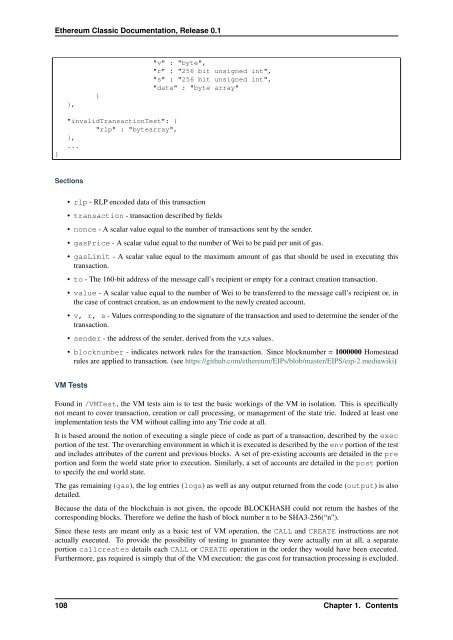Whitepaper - Ethereum Classic With Cover
Create successful ePaper yourself
Turn your PDF publications into a flip-book with our unique Google optimized e-Paper software.
<strong>Ethereum</strong> <strong>Classic</strong> Documentation, Release 0.1<br />
},<br />
}<br />
"v" : "byte",<br />
"r" : "256 bit unsigned int",<br />
"s" : "256 bit unsigned int",<br />
"data" : "byte array"<br />
}<br />
"invalidTransactionTest": {<br />
"rlp" : "bytearray",<br />
},<br />
...<br />
Sections<br />
• rlp - RLP encoded data of this transaction<br />
• transaction - transaction described by fields<br />
• nonce - A scalar value equal to the number of transactions sent by the sender.<br />
• gasPrice - A scalar value equal to the number of Wei to be paid per unit of gas.<br />
• gasLimit - A scalar value equal to the maximum amount of gas that should be used in executing this<br />
transaction.<br />
• to - The 160-bit address of the message call’s recipient or empty for a contract creation transaction.<br />
• value - A scalar value equal to the number of Wei to be transferred to the message call’s recipient or, in<br />
the case of contract creation, as an endowment to the newly created account.<br />
• v, r, s - Values corresponding to the signature of the transaction and used to determine the sender of the<br />
transaction.<br />
• sender - the address of the sender, derived from the v,r,s values.<br />
• blocknumber - indicates network rules for the transaction. Since blocknumber = 1000000 Homestead<br />
rules are applied to transaction. (see https://github.com/ethereum/EIPs/blob/master/EIPS/eip-2.mediawiki)<br />
VM Tests<br />
Found in /VMTest, the VM tests aim is to test the basic workings of the VM in isolation. This is specifically<br />
not meant to cover transaction, creation or call processing, or management of the state trie. Indeed at least one<br />
implementation tests the VM without calling into any Trie code at all.<br />
It is based around the notion of executing a single piece of code as part of a transaction, described by the exec<br />
portion of the test. The overarching environment in which it is executed is described by the env portion of the test<br />
and includes attributes of the current and previous blocks. A set of pre-existing accounts are detailed in the pre<br />
portion and form the world state prior to execution. Similarly, a set of accounts are detailed in the post portion<br />
to specify the end world state.<br />
The gas remaining (gas), the log entries (logs) as well as any output returned from the code (output) is also<br />
detailed.<br />
Because the data of the blockchain is not given, the opcode BLOCKHASH could not return the hashes of the<br />
corresponding blocks. Therefore we define the hash of block number n to be SHA3-256(“n”).<br />
Since these tests are meant only as a basic test of VM operation, the CALL and CREATE instructions are not<br />
actually executed. To provide the possibility of testing to guarantee they were actually run at all, a separate<br />
portion callcreates details each CALL or CREATE operation in the order they would have been executed.<br />
Furthermore, gas required is simply that of the VM execution: the gas cost for transaction processing is excluded.<br />
108 Chapter 1. Contents
















